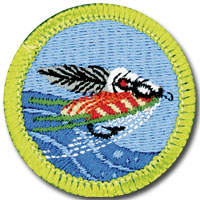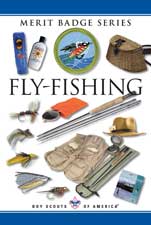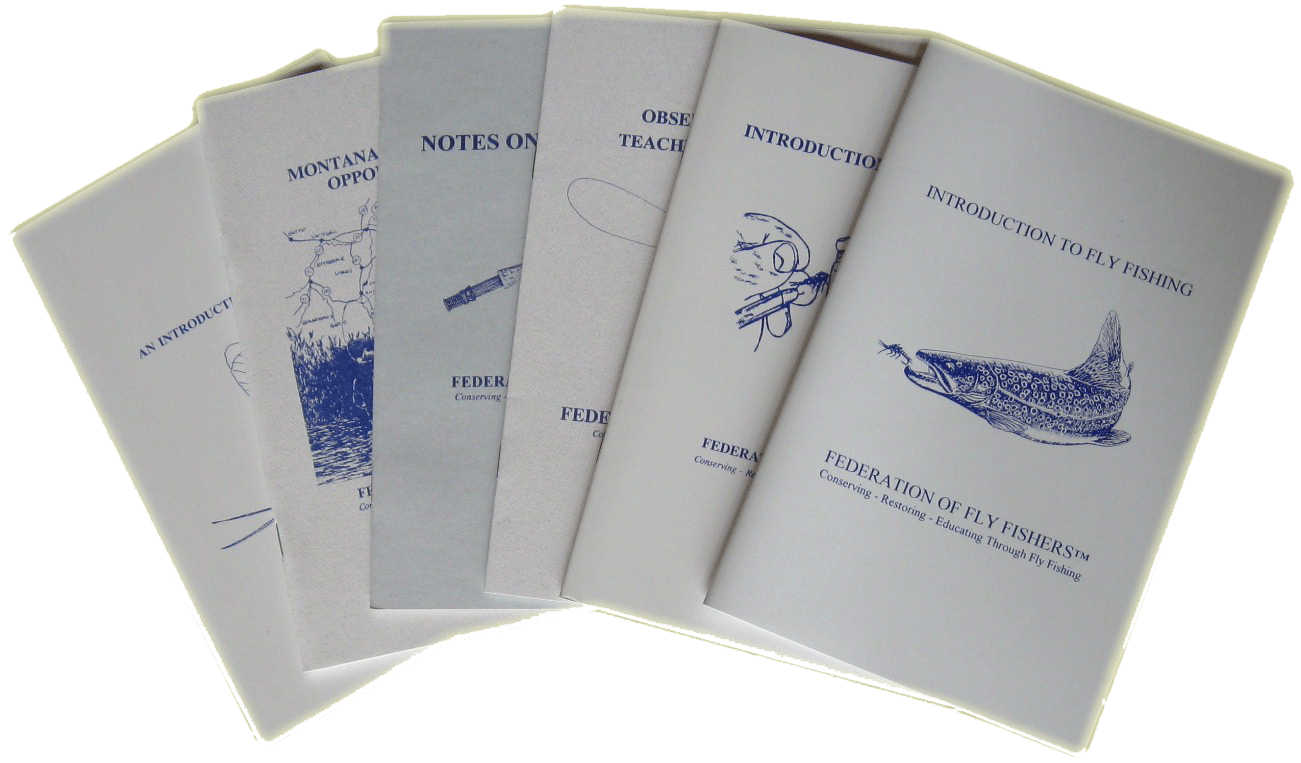SCOUTING AMERICA MERIT BADGE IN FLY FISHING
Get involved with Scouting America
|
|

The Scouting America Badge in Fly Fishing is now available. The FFF hopes some of you will become merit badge counselors. Check the Scouting America website for counselor forms and click on the "Get Involved" to find a troop near you. The Meritbadge.com website is another excellent tool for finding Scout information
This merit badge can be taught in about 18 to 20 hours plus a ½ to 1 day on-the-stream fishing experience. Plan a 1 to 3 day course on the weekend or 2 to 3 hours in the evening each week at the scout meeting to teach this badge. Tailor your schedule to the scouts and volunteers.
Some requirements can be met by including the scouts in your club's current fly tying, fly fishing or casting classes. This would lower your volunteers' commitments. Be sure to have a "merit badge counselor" sign off on each scout for each requirement met.
This program covers all aspects of fly fishing, including a fishing trip component. So, plan a ½ to 1 day fishing trip to finish the on-stream requirements. Make insect observations, look for flying insects, roll rocks, and "Match the Hatch" with flies your scouts have tied. Assist the scouts in catching at least 1 fish. If you fish in "catch and release only" waters - release the fish. If you fish on a "put and take" stream discuss cleaning and cooking the fish or schedule a separate time for the scouts to get together and cook fish using "put and take" fish or market fish. HAVE GREAT FUN!
|
|
Requirements
(direct from the Scouting America website)
1. Do the following:
- Discuss the prevention of and treatment for health concerns that could occur while fly-fishing, including cuts and scratches, puncture wounds, insect bites, hypothermia, dehydration, heat exhaustion, heatstroke, and sunburn.
- Explain how to remove a hook that has lodged in your arm.
- Name and explain five safety practices you should always follow while fly-fishing.
2. Demonstrate how to match a fly rod, line, and leader to achieve a balanced system. Discuss several types of fly lines, and explain how and when each would be used. Review with your counselor how to care for this equipment.
3. Demonstrate how to tie proper knots to prepare a fly rod for fishing:
- Tie a backing to a fly reel spool using the arbor knot.
- Attach backing to fly line using the nail knot.
- Attach a leader to fly line using the needle knot, nail knot, or a loop-to-loop connection.
- Add a tippet to a leader using a loop-to-loop connection or blood knot.
- Tie a fly onto the terminal end of the leader using the improved clinch knot.
4. Explain how and when each of the following types of flies is used: dry flies, wet flies, nymphs, streamers, bass bugs, poppers, and saltwater flies. Tell what each one imitates. Tie at least two types of the flies mentioned in this requirement.
5. Demonstrate the ability to cast a fly 30 feet consistently and accurately using both overhead and roll cast techniques.
6. Go to a suitable fishing location and observe what fish may be eating both above and beneath the water’s surface. Explain the importance of matching the hatch.
7. Do the following:
- Explain the importance of practicing Leave No Trace techniques. Discuss the positive effects of Leave No Trace on fly-fishing resources.
- Discuss the meaning and importance of catch and release. Describe how to properly release a fish safely to the water.
8. Obtain and review a copy of the regulations affecting game fishing where you live or where you plan to fish. Explain why they were adopted and what is accomplished by following them.
9. Discuss what good outdoor sportsmanlike behavior is and how it relates to anglers. Tell how the Outdoor Code of the Scouting America relates to a fishing enthusiast, including the aspects of littering, trespassing, courteous behavior, and obeying fishing regulations.
10. Catch at least one fish and identify it. If local fishing and health regulations allow it, clean and cook a fish you have caught. Otherwise, acquire a fish and cook it.

|
Example Agenda
This agenda was originally set up for a Saturday and Sunday class but has been increased to about 18 to 20 hours to cover all needed requirements. Schedule 2 weekends or 3 days for the classes.
Day 1
8:30-9:00 a.m. Class setup, registration, etc.
9:00 a.m. Introduction, overview
9:10 a.m. "Fish we fly fish for..."
9:15 a.m. Consider a Fly Fishing Outfit and its Components - Rods, Reels, Lines, Leaders
10:10 a.m. Break
10:30 a.m. Introduction to Casting
11:15 a.m. Stewardship/Ethics of the Sport, lunch, Q&A
12:00 noon Split into 2 groups
12:15 p.m. 2 Group Activities - Casting & Knot Tying. Half of the class in each group.
1:30 p.m. Switch groups
3:00 p.m. Break
3:15 p.m. Tackle Talk
3:45 p.m. Questions, comments, wrap-up
Day 2
9:00 a.m. Video
9:30 a.m. Reconvene class
9:40 a.m. Slide show - Introduction to Flies
11:00 a.m. Break
11:15 a.m. Safety - Wading, Hook removal, etc.
11:45 a.m. Lunch / Clean Up Classroom / Knot Review /Q & A
12:45 p.m. 2nd Casting Session & Moving Water Tactics
1:45 p.m. Switch Groups
2:45 p.m. Break - reconvene in one group
3:00 p.m. Closing Remarks, Questions, Clarifications, etc.
Day 3
9:00 a.m. Fly Tying Equipment
9:30 a.m. Materials and Hooks
10:00 a.m. Break
10:15 a.m. Beginning Techniques
11:00 a.m. Wooly Bugger
12:00 a.m. Lunch / Q & A
1:00 p.m. Mickey Finn
2:00 p.m. Review or another fly
3:00 p.m. Close
|
Preparing for This Program
Put one person in charge to contact local scout troops, coordinate your program, and get volunteers to teach different parts of the program.
Pick the site as early as possible. The ideal site is a classroom or community center with a large lawn for casting. Water is nice but not required. Tables and chairs and audio-visual equipment to accompany your program should also be rented ahead of time.
Plan food and drinks to compliment your scout's tastes. Scouts may also bring their own food and your group provides only coffee and pop.
Costs of your program depend on you. You should cover expenses but may wish to give the classes free or have the scouts purchase the supplies they need.
Pre-package handouts, support materials, FFF and club materials and 2 colors of fly line or rope to use in the knot lab with badges in an envelope for easy distribution at the first class.
Use 2 colors of badges to distinguish instructors from students as not all instructors will be presenters and so they can be more easily found during breaks.
If possible have a "give away" table of catalogs, old fly fishing magazines and other free things for the students. Allow anyone to read what is on the table the first day and take home what they want on the last day.
Have students bring equipment if they have it and gather other loaner equipment from the club, shop owners or instructors who have extra so everyone has some different outfits to try. Fly tying equipment and rods and reels are also available from the Federation. Check the FFF website at www.fedflyfishers.org or call the FFF Headquarters at 406-222-9369.
Put one person in charge of the loaner equipment when moving from one area to another to avoid losing equipment or breaking it on low ceilings and doorways.
|
Needs for This Program
Videos that are appropriate to your area fishing and waters, videos to emphasize personal involvement in conservation issues. These videos and others are available from the FFF Video loaner program. Check the FFF website.
"Where the Trout Are" by Gary Borger, with teaching guide, available from the FFF website.
"Anatomy of a Trout Stream" by Rick Hefele.
"All New Casting Techniques" by Lefty Kreh.
"Three Men Three Rivers" available from Montana Dept. of Fish, Wildlife and Parks, PO Box 9211, Helena, MT 59604.
"Essences of Flycasting" I and II by Mel Kreiger.
"Fly Tying Basics" by Al Beatty.
Paper & pencil or pens
Your club brochures, FFF membership and Catch & Release brochures "Fly Fishing" merit badge book - #35900 (supply division catalog) available from http://www.scouting.org or your local scout council.
Resource Articles to promote individual participation in conservation issues and fly fishing etiquette.
Catalogs or copies of pages showing beginners kits available for fly fishing and fly tying.
Fish photos and/or slides for the "Fish We Fish For . ." section.
List of books, videos and periodicals from your own favorites list or see list below.
FFF booklets available from the FFF website at http://www.fffgear.com/ or call the national office at 406-222-9369. Booklets you’ll need are:
"Introduction to Fly Tying"
"Introduction to Aquatic Insects"
"Introduction to Fly Fishing"

|
Equipment
- "Complete Outfits" in many sizes and uses. These can be taken apart to demonstrate different areas of your program.
- Rods, reels, lines, backing, rod cases and socks.
- Lines in double taper, weight forward, floating, sink tip, level taper.
- Rope or old fly line for knot tying labs.
- Wood block with screw eye to be a "hook" for the Knot Lab.
- Leader material - knotted tapered and machine tapered.
- FLY-O rods if available.
- Flies used in your area for the various types of fishing available. You may also want to do a slide show or enlarge photographs of these flies.
- Fly tying kits with basic tools.
- Fly tying materials appropriate to the flies taught.
- Float tubes if you plan to discuss this type of fishing.
- Glasses, hats, vests, "gadgets" and anything else attached you plan to discuss.
- Waders - chest and hip, boat foot and sock foot, wading boots and wading belts if you plan to talk about this type of fishing.
- Equipment for classes can also be borrowed from the FFF or your local Council. Check the FFF website http://www.fedflyfishers.org or your local council site.
|
Sample Program Outline
Click Here to Download Document (PDF)
|
Local Shops
This handout for your students should include your local shops. Add them here. They have earned your support. See a list of our member shops.
Fly Fishing Mail Order Sources
There are many first rate mail order sources of fly tackle. You will find them listed in the various fly fishing magazines & publications and increasingly on the Internet. Here are some to start with, but they are simply representative and not recommended above the others. The catalogs are free. See our Retail Members for a shop near you!
- Angler's Workshop, PO Box 1910, 1350 Atlantic Ave., Woodland, WA 98674
- Cabela's, One Cabela Drive, Sidney, NE 69160 (ask for fly fishing catalog)
- Cold Spring Anglers, 419 East High Street, Ste A, PO Box 129, Carlisle, PA 17013-0129
- Dan Bailey's Fly Shop, PO Box 1019, Livingston, MT 59047 (nice color plates of flies)
- Feather-Craft Fly Fishing, PO Box 19904, 8307 Manchester Rd, St. Louis, MO 63144
- The Hook & Hackle Company, 7 Kaycee Loop Rd., Plattsburgh, NY, 12901. Free Catalog
- Kaufmann's Streamborn, INC., PO Box 23032 RR, Portland, OR 97281-3032.
- L. L. Bean, 15 Casco Street, Freeport, ME 04033 (ask for fly fishing catalog).
- Madison River Fishing Company, 109 Main Street, Ennis, MT 55729.
- Orvis, Rt. 7A, Manchester,VT. 05254
|
Further Suggested Reading
Basic
Introduction to Fly Fishing; Federation of Fly Fishers
The Essentials of Fly Casting; Federation of Fly Fishers
Catch and Release Guidelines; Federation of Fly Fishers
The Curtis Creek Manifesto; Sheridan Anderson
L. L. Bean Fly Fishing Handbook; Dave Whitlock. Especially recommended
The Orvis Fly Fishing Guide; Rosenbauer
General Reading
Fishing the Flats; Kreh & Sosin (saltwater)
Fly Fishing Always; Wolverton ed. (FFF)
Fly Fishing for Smallmouth Bass; Harry Murray
Fly Fishing for Trout, a Guide for Adult Beginners; Dick Talleur
Fly Fishing the High Country; Arnold Gierach
Fly Rodding for Bass; Livingston
Fly Tying & Fly Fishing for Bass and Panfish; Tom Nixon
Lake Fishing With a Fly; Cordes & Kaufmann
Montana Fly Fishing Opportunities; Federation of Fly Fishers
Practical Fishing Knots; Kreh & Sosin
Tactics for Trout; Dave Hughes
Advanced Reading
Fly Fishing Strategy; Swisher & Richards
The Masters on the Dry Fly; Migel ed.
The Masters on the Nymph; Migel & Wright ed. Notes on Rod Building; Federation of Fly Fishers
Nymphing; Gary Borger
BUGS An Introduction to Aquatic Insects; Federation of Fly Fishers
Caddisflies; Gary LaFontaine
Dave Whitlock's Guide to Aquatic Trout Food; Dave Whitlock
Hatches II; Caucci & Nastasi
Naturals, a Guide to Food Organisms of the Trout; Gary Borger
Selective Trout; Swisher & Richards
FLY TYING Introduction to Fly Tying; Federation of Fly Fishers
The Basic Manual of Fly Tying; Fling & Puterbaugh
Bass Flies; Stewart
The Complete Book of Fly Tying; Eric Leiser
Expert Fly Tying; Fling & Puterbaugh
Fly Tyers Primer; Dick Talleur
Universal Fly Tying Guide; Stewart
Literature
A Leaf From French Eddy; Ben Hur Lampman
Confessions of a Fly Fishing Addict; Nick Lyons
Death of a Riverkeeper; Ernie Schwiebert
Fishing Widows; Nick Lyons
Open Season; William Humphrey
Remembrances of Rivers Past; Ernie Schwiebert
Silent Seasons; Russell Chatham
Sex, Death and Fly Fishing; John Gierach
Trout Bum; John Gierach
The Anglers Astoria; Dave Hughes
The Habit of Rivers, Reflections on Trout Streams and Fly Fishing; Leeson
The Seasonable Angle; Nick Lyons
The Spawning Run; William Humphrey
The View From Rat Lake; John Gierach
Trout Madness; Robert Traver
Trout Magic; Robert Traver
Year of The Angler; Steve Raymond
Periodicals
American Angler, PO Box 4100, 160 Benmont Ave., Bennington, VT. 50201
Fly Fisherman, 6405 Flank Drive, Harrisburg, PA 17112
The Flyfisher (Federation of Fly Fishers), 5237 US Highway 89 S, Suite 11, Livingston, MT 59047
Fly Rod & Reel, PO Box 370, Camden, ME 04843
Midwest Fly Fishing, 4030 Zenith Ave. South, Minneapolis, MN 55410
Videos
There are a wide variety of videos available to further your fly fishing knowledge - some basic, some fairly specialized. The 3M/Scientific Angler company has quite a few good ones, especially the Mastery series. Most any programs from Gary Borger (fishing dry flies, fishing nymphs), Doug Swisher (casting, strategy), Mel Krieger (fly casting) or Lefty Kreh are well presented and worth your time. There are also many programs of fly tying instruction and at least one on rod building. Some especially recommended tapes are:
Anatomy of a Trout Stream, by Rick Hafele (3M) - basic understanding of a trout stream and how to fish the various areas. Fly Fishing for Bass, by Dave Whitlock Fly Tying Basics, by Al Beatty The Way of the Trout, by Jim Wilkie & TU Where The Trout Are, by Gary Borger & FFF
Many videos are available for rent from fly fishing shops or on the FFF Web site at www.fedflyfishers.org.
Roll Casting the Web...Fly Fishing Web Sites
If you have access to the World Wide Web there are some interesting sites to serve your new found interest in fly fishing. You can find information on products, guide services, classified ads for locating used equipment and especially information exchanges. No guarantees come with these sites, but you'll find listed below some suggestions for places to start. *note: all links will open in a new window
http://www.mwfly.com Midwest Fly Fishing site - a favorite publication Links to other sites.
www.flyshop.com The Virtual Flyshop. Good basic site for flyfishing info. Classified ads for used equipment. Active auction site.
www.flyfishing.com Another general site, some commercial, some not. More classified ads.
www.flyfish.com Same again....
www.globalflyfisher.com Fly tying information.
www.flyfishjournal.com On-line fly fishing "magazine."
www.flyfishamerica.com On-line fly fishing "magazine."
www.flyfishersinternational.org Fly Fishers International home page.
www.wisflyfishing.com The Wisconsin fly fishing page.
http://www.ag.purdue.edu/entm/Pages/default.aspx Perdue University Entomology Central
http://www.canerod.com/rodmakersBamboo rod making site.
There are others, but we'll leave them to you to discover. The process of discovery is half the fun.
Other Helpful Resources & Thanks
Lew Beccone and the Minnesota Fly Fishers have several articles and other resources they use in the packet for students along with the book "Fly Fishing Tactics." We would like to acknowledge the authors for their contribution to teaching conservation and fly fishing safety and etiquette to the students. These articles are available in the FFF Resources Handbook.
"Seven Days in June Seven Men From Chicago" by Kurt Sleighter, from Smallmouth Alliance Newsletter, August-September 1992. The over fishing of a lake.
"Thieves of a Stream" by Greg Breining, from the magazine "Imprint," Spring 1989. An article on conservation.
"Fly Fishing Etiquette" by Tom & Krys Travis, an article on stream etiquette.
"Rules of the River" by Agust Kr. Gudmundsson, from the web site . Stream etiquette.
"Fly Fishing Etiquette" from REI the website
"Wading Safety" from REI the website
"Basic Flyrod Bassing" by Brian McKinley, all about bass fishing with a fly rod.
|